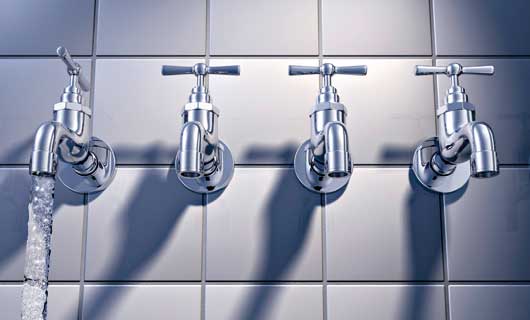The 80 per cent solution
By recycling used water, we can live with just a couple of buckets of fresh, clean water a day, while the rest of our water will come from recycled sources.
We eat, we drink, we prepare food. We have a bath or shower, we brush our teeth and flush the toilet. We hose down our cars and pavements, water the garden and wash the floor.
That adds up to an average use of 200 litres per person in the average European household, whereas in North America and Japan that number is closer to 350 litres per day.
Traditional water and sewage systems are based on one pipe to supply clean water, and one pipe that transports the wastewater and sewage away.
All the water that comes into a house, in other words, is carefully treated to drinking water standards.
In terms of hygiene, we could all manage with a couple of buckets of clean water a day. Just 20 per cent of our daily water use is for drinking, making food and personal hygiene. The remaining 80 per cent could easily be of a much lower quality.
Researchers at NTNU have sketched a method for the recycling of household water. With this approach, the demand for supplies of clean water can be reduced to about 20 litres per day.
The remainder can be taken from cleaned and recycled water and from collected rainwater. High quality water can be brought to the house in a pipe, pumped up from the ground or delivered via tanker truck.
Four water taps
This approach requires water to be divided into at least three different levels of quality supplied by four water taps.
The best quality would be reserved for drinking, making food and personal hygiene, while the next lower quality would be used for washing dishes and clothes and cleaning the house. The lowest quality water would be used outside for washing cars and watering gardens. This quality would also be used to flush toilets.
Used water from the two highest quality levels would be cleaned and collected in a reser- voir, where nature’s self-cleaning processes can occur. The reservoir would also work as storage to even out water supplies. Water that has been used outside will naturally drain away and be cleansed by the soil, and eventually can be collected in a reservoir.
Sewage from the toilet would be completely taken out of the recycling loop. It should total about 20 litres a day, about the same amount as the clean water that was supplied to the system in the first place.
The organic matter from the toilet can be separated and treated hygienically so that it can be reused as fertilizer.
The water that is not provided from outside the system is returned, after new treatment (depending upon the quality) to users. This would be from smaller reservoirs that are dug near individual houses or larger reservoirs that supply an entire neighbourhood.
The recirculation system can be comprised of groups of houses, hotels, different institutions or office buildings.
Urbanization provokes water crisis
This kind of solution will be absolutely necessary in countries with serious water problems in large cities, if people are going to have access to the water they need.
“Urbanization is one of the most important reasons behind the world’s water crisis,” says Professor Hallvard Ødegaard, at NTNU’s Department of Water and Environmental Engineering. “The problem is partly due to the lack of adequate freshwater sources for growing populations, but also because the infrastructure (the water and sewer networks) in large cities is aging and is expensive to refurbish.”
“Water supplies and sewers will be a central element in city planning in the future. And their development will tend towards more decentralized solutions, where newly built-up areas will to an increasing extent plan on supplying themselves with freshwater.”
“This will occur though extensive cleansing, recirculation and recycling of used water,” says Ødegaard – who together with Per Kristian Vestre at NTNU’s Technology Transfer Office has developed the concept that uses four water taps.
By Synnøve Ressem
Contact: Hallvard Ødegaard, Department of Water and Environmental Engineering, NTNU
Phone: +47 73 59 47 59 Email: [email protected]
This article is also published at EarthSky


